Our Verdict
The GeForce RTX 3070 Ti delivers frustratingly variable performance, often too close to an RTX 3070 for a price smack between it and the RTX 3080. It doesn't have quite the same impact as Ampere's best cards, but at the very least offers PC gamers another chance to pick up a graphics card at MSRP this year.
For
- High frame rates at 1440p
- Perfectly passable 4K
- Solid upgrade for 10-series owners
Against
- Hottest Founders Edition yet
- Power hungry
- Often closer to RTX 3070 performance than 3080
- Loses key battles to Radeon RX 6800
PC Gamer's got your back
There's a hole in the GeForce lineup and the new GeForce RTX 3070 Ti is the card with which Nvidia hopes to plug it up. Prior to the RTX 3070 Ti's release it was a space wholly occupied by AMD's Radeon RX 6800, which is perhaps why Nvidia sees it a vital gap to fill as quickly as possible. It aims to do so with a blend of the RTX 3070's full GPU and the RTX 3080's speedy memory, all combined into one card, which will deliver high frame rate 1440p and more affordable 4K gaming.
The RTX 3070 Ti sits directly between the GeForce RTX 3070 and GeForce RTX 3080, but doesn't have any ideas of supplanting either one. Rather, with a $599 (£529, €619) price tag, it is an exercise in shoring up the GeForce RTX 30-series lineup should any gamer get any wild ideas about jumping ship to team Radeon.
It does just that too, which doesn't make it the most exciting graphics card launch from a PC gamer's perspective. But at a time like this, when graphics cards are all too hard to come by, and even more so at MSRP, its greatest strength may not be in exceptional price or game-changing performance but instead in the mere fact it exists.
Specs

What are the Nvidia GeForce RTX 3070 Ti specs?
The GeForce RTX 3070 Ti is mostly created from parts skimmed from the existing RTX 30-series GPU stack. As such, you'll find no major surprises on this card, but that's not to say there haven't been adjustments to offer something new.
First off, there's the GA104 GPU. The RTX 3070 Ti uses the complete, uncut GPU only currently found within the mobile RTX 3080. It's confusing, and AMD has similarly chosen to name its mobile GPUs in such an obfuscating fashion to make matters worse. Nonetheless, what will be key to desktop PC gamers is that this is a slightly more performant version of the GA104 GPU found within the RTX 3070. It achieves this extra power with a moderate CUDA Core increase: 6,144 on the RTX 3070 Ti to the 5,888 on the RTX 3070.
That's less than a 5% increase in CUDA Cores from the RTX 3070 moving to the RTX 3070 Ti.
You can also expect boost clocks to officially top 1,770MHz with the RTX 3070 Ti, which is a little higher than the 1,725MHz found on the RTX 3070 FE. During three runs of Metro Exodus at 4K, however, that clock speed lead falls away, and it was actually the RTX 3070, with the help of GPU Boost, which comes out ahead at 1,862MHz to the RTX 3070 Ti's 1,829MHz.
That could be down to thermal headroom, which as you'll see later the RTX 3070 FE appears to have a more generous helping of.
Passing on any significant shake-up in the GPU silicon, Nvidia has instead seen fit to equip the RTX 3070 Ti with GDDR6X memory. That's the same speedy memory found in the RTX 3080, GeForce RTX 3080 Ti, and GeForce RTX 3090. This sees the RTX 3070 Ti arrive with 608GB/s, a notable improvement on the RTX 3070's 448GB/s, despite both featuring an identical 256-bit wide memory bus.
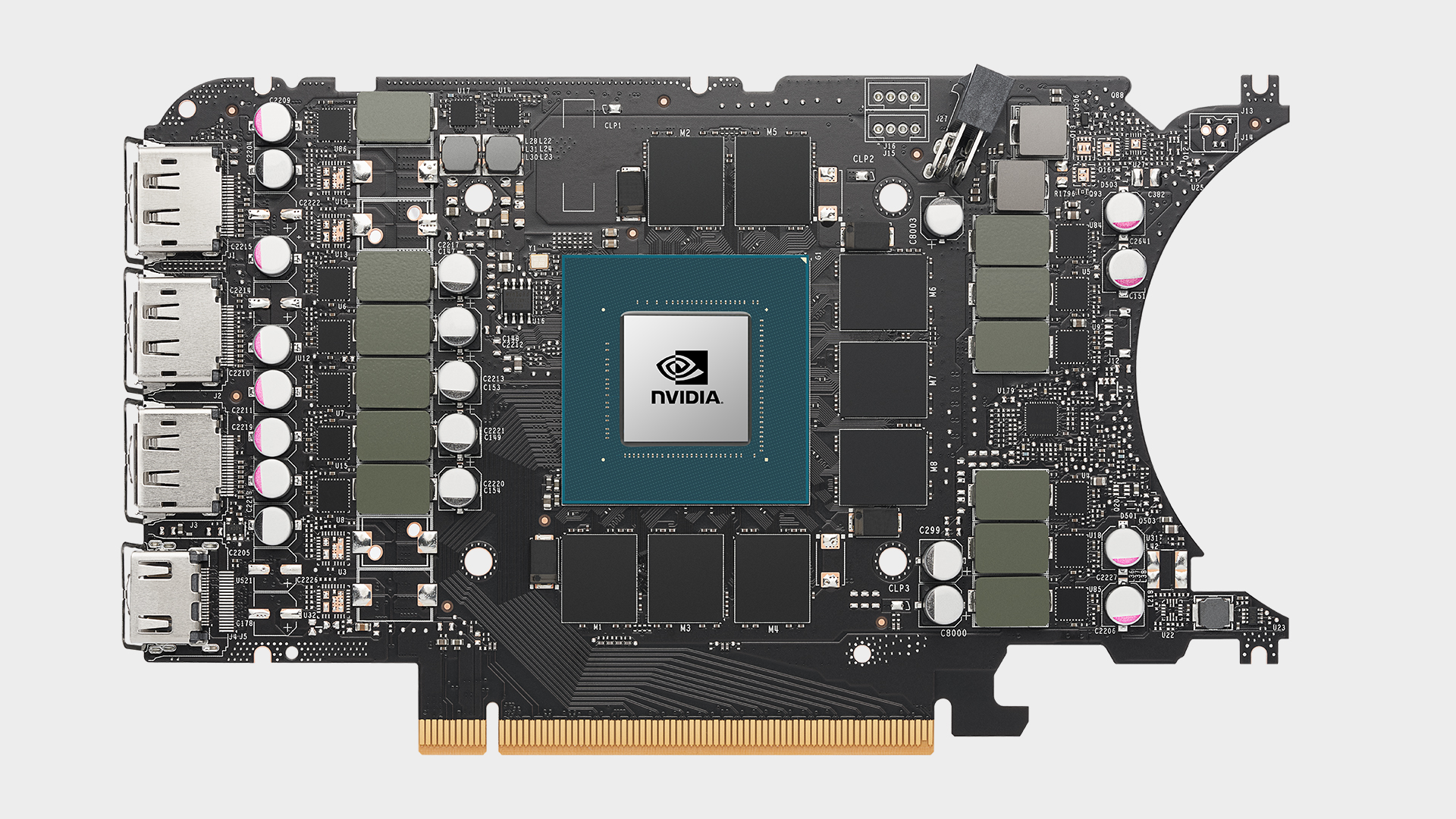
GPU - GA104
Lithography - Samsung 8nm
CUDA Cores - 6,144
SMs - 48
RT Cores - 48
Tensor Cores - 192
GPU Boost clock - 1,770MHz
Memory bus - 256-bit
Memory capacity - 8GB GDDR6X
Memory speed - 19Gbps
Memory bandwidth - 608GB/s
TGP - 290W
Price - $599 (£529, €619)
GDDR6X's secret is PAM4 signalling, which effectively doubles the number of signals the memory transmits with each clock. It's not quite doubly effective in practice, unfortunately for us, but it has allowed its manufacturer, Micron, to deliver 19Gbps with GDDR6X, while GDDR6 manages just 14Gbps.
So there's great pedigree in that memory technology, which is at the bleeding edge of high-bandwidth chips today. Micron doesn't offer it out freely, either. Nvidia is, so far, the only GPU manufacturer to offer it in its products. I'd expect it to stay that way, too; GDDR5X memory remained an Nvidia-exclusive for the duration of its life.
Yet while GDDR6X offers Nvidia speed beyond the grasp of the competition, it has only seen fit to load 8GB of the fancy memory onto the RTX 3070 Ti. That puts it at a loss next to the 16GB AMD Radeon RX 6800, which launched a bit too pricey at $579 for consideration next to the RTX 3070, but is now nominally a little cheaper than the $599 RTX 3070 Ti.
In memory terms, then, you have the speedier, smaller GeForce RTX 3070 Ti facing down the slower, more capacious Radeon RX 6800. The deciding factor is, of course, gaming performance, and once again there's plenty to talk about when comparing Nvidia Ampere and AMD RDNA 2. More on that in the performance section below.
Its greatest strength may not be in exceptional price or game-changing performance but instead in the mere fact it exists.
Back to the RTX 3070 Ti for a moment and let's talk construction.
Nvidia has opted for a new Founders Edition shroud with the RTX 3070 Ti, a sort-of middle ground between the RTX 3070 and RTX 3080 FE coolers. In essence, it looks the part of the RTX 3070 cooler except it's a little longer, and that allows Nvidia to mount a single fan on both sides of the card. Nvidia calls this 'flow-through cooling' and it's something you'll spot on the RTX 3080 and above too. Also there are more heatpipes than the RTX 3070 FE, with a total of six running through the RTX 3070 Ti to wick heat away from the GPU, memory, and VRM components rapidly.
This cooler redesign may be essential to the internal overhaul. With a slightly tougher job keeping the RTX 3070 Ti's components cool, the card ends up reaching higher temperatures under load than I had expected: 75°C on average across three runs of Metro: Exodus at 4K.
That's pretty toasty by today's standards. It's still a happy enough medium for any case with decent airflow, but the 3070 Ti has been the hottest of all the Founders Edition cards in our testing.
It's a given, then, that the RTX 3070 Ti consumes more power from the PSU than the RTX 3070. And does so by some margin. The RTX 3070 comes with a TDP of 220W while the RTX 3070 Ti demands 290W. In operation, the RTX 3070 Ti chewed through 291W of power, while the RTX 3070 stuck to 222W.
A larger GPU and thirstier GDDR6X chips beget greater power demands and more heat generation, that's a given, but the unequal increases with this card are perhaps proof of the balancing act that modern GPUs must maintain for peak power efficiency and performance. In the RTX 3070 Ti's case, that's a slightly more shaky tightrope walk than the RTX 30-series cards before it.
And it carries through into pricing, too. The RTX 3070 Ti is a $599 graphics card, straddling the RTX 3070 at $499 and the RTX 3080 at $699. In theory, anyways.
I say that for obvious reasons: the graphics card market is anything but healthy today and finding any modern graphics card at MSRP is a struggle. That said, you will at least be able to find the RTX 3070 Ti for a brief moment in time at MSRP, which will inevitably end up as one of the cheapest prices for that graphics card you'll find for the foreseeable future.
What really matters, though, is that, for all the specification and price changes, Nvidia's tinkering equates to a notable and justifiable improvement in frame rates. With that, let's get into the numbers.
Performance

How fast is the Nvidia GeForce RTX 3070 Ti?
4K performance
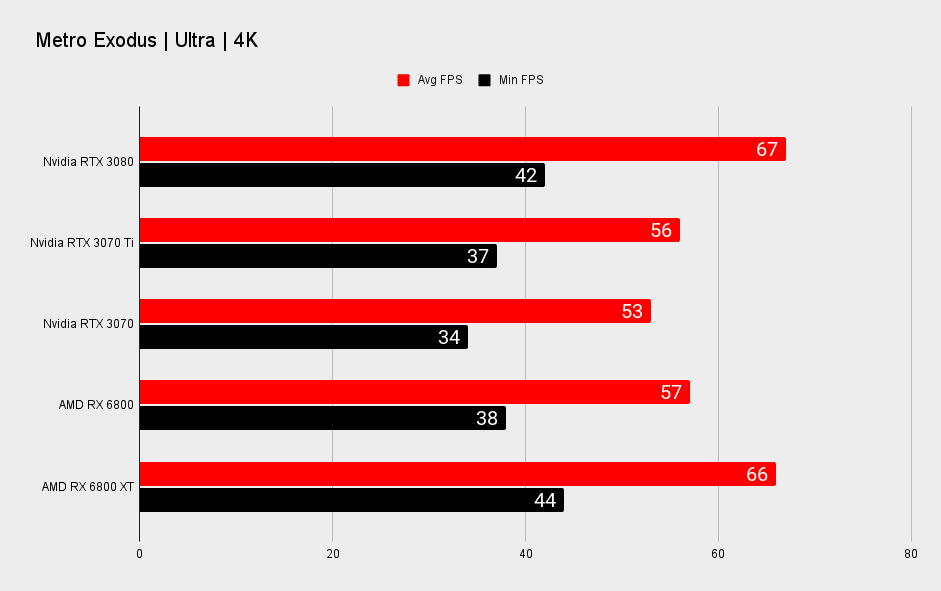
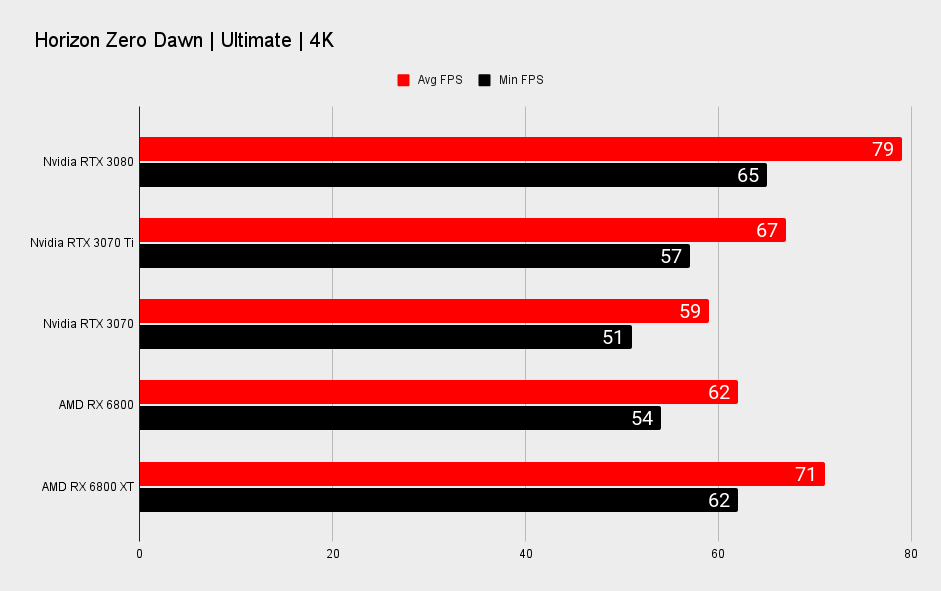


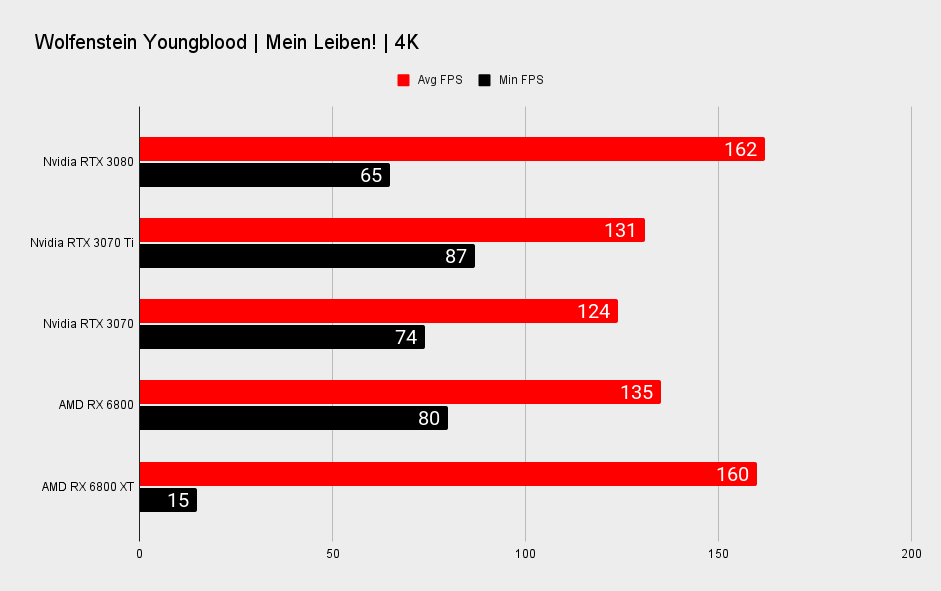

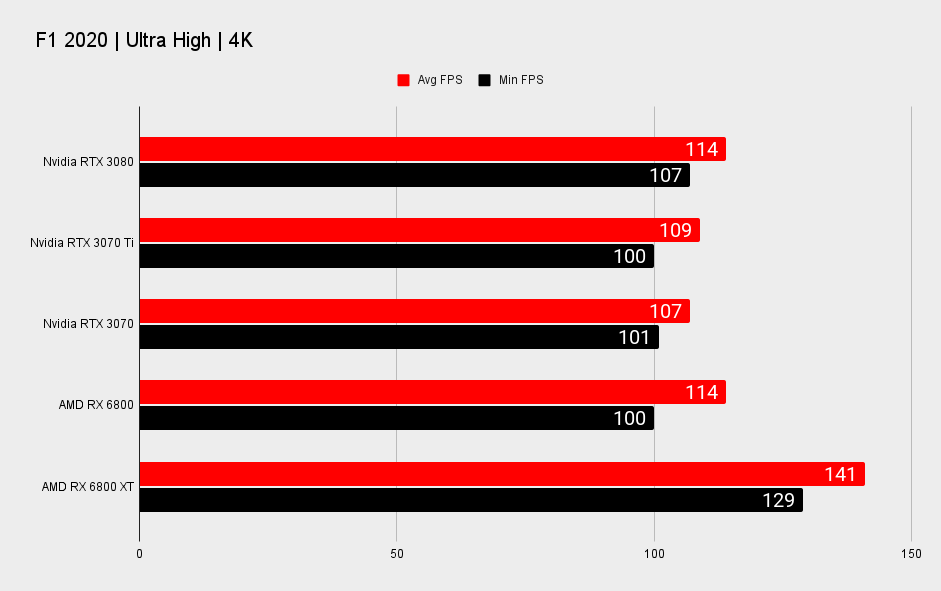

CPU - Intel Core i7 10700K
Motherboard - MSI MPG Z490 Gaming Carbon WiFi
RAM - Corsair Vengeance RGB Pro @ 3,200MHz
CPU cooler - Corsair H100i RGB Pro XT
PSU - NZXT 850W
Chassis - DimasTech Mini V2
Let's start at 4K, which is a bit more of a reach for the RTX 3070 Ti than say the RTX 3080, yet most definitely within its wheelhouse.
Generally, 4K gaming enjoys memory bandwidth, and comparatively the RTX 3070 Ti has that in swathes versus the RTX 3070 or GeForce RTX 3060 Ti. It's a card more naturally inclined to the demanding Ultra HD resolution, but importantly it's also able to offer a little more bandwidth than the RX 6800—608GB/s to 512GB/s—and that sees both cards competing within a frame or two of each other within many of our benchmarks.
This performance battle goes down to the wire. Game-by-game you're looking at marginal leads in either direction; or every game the RTX 3070 Ti leads, the RX 6800 comes right back at it in another.
That makes for plenty playable 4K frame rates with the RTX 3070 Ti. In less demanding games it will glide past 60fps, and in more demanding titles you may be only a few settings tweaks away from that all-important performance milestone.
Metro Exodus Enhanced Edition and the surprisingly demanding Total War: Three Kingdoms require more drastic action to bring them in line, but the RTX 3070 Ti is a decent way into 4K gaming. I'd still recommend the RTX 3080 for 4K gaming if you could stretch to it, stock and pricing pending, as its extra oomph sees it more comfortably surmount the demands of high resolution gaming.
1440p performance

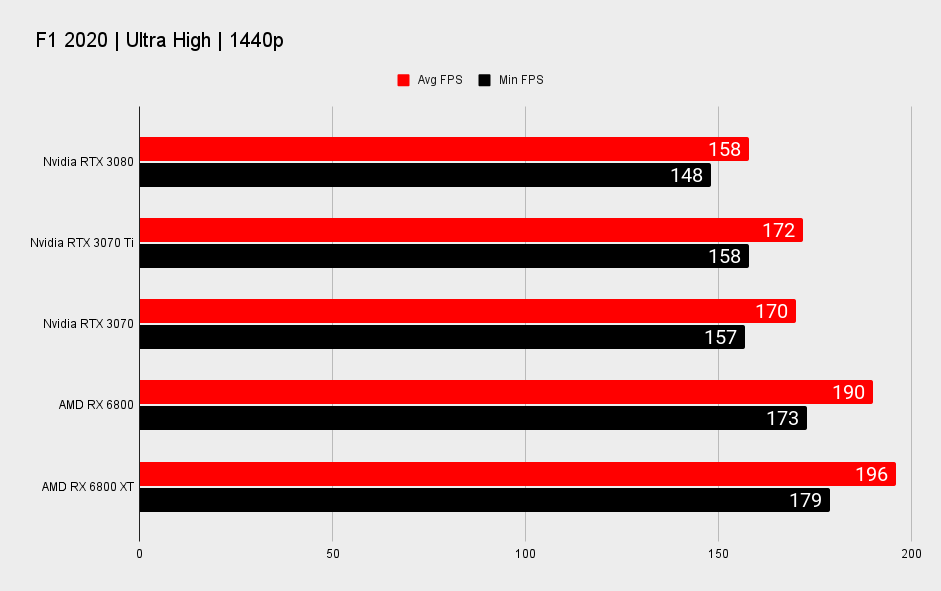
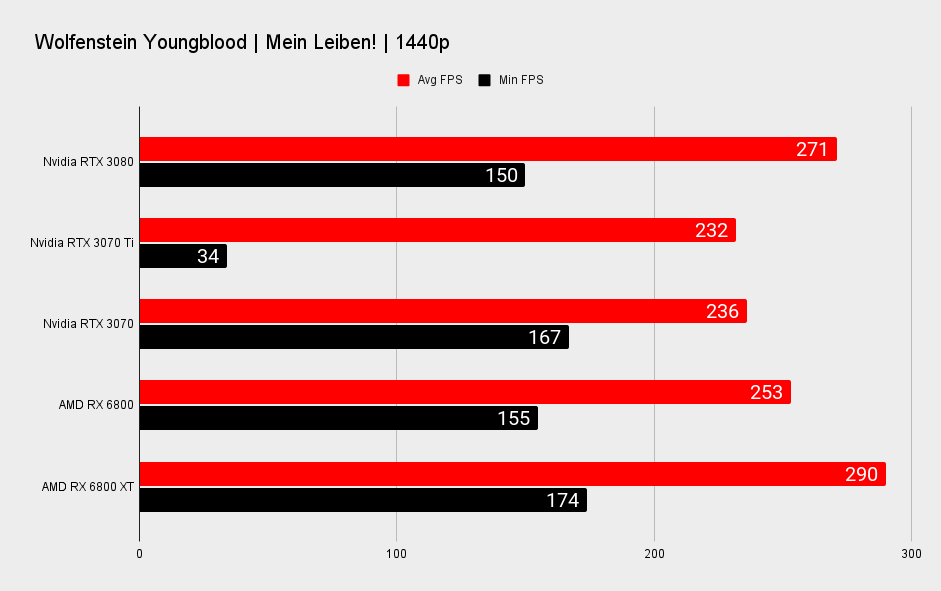
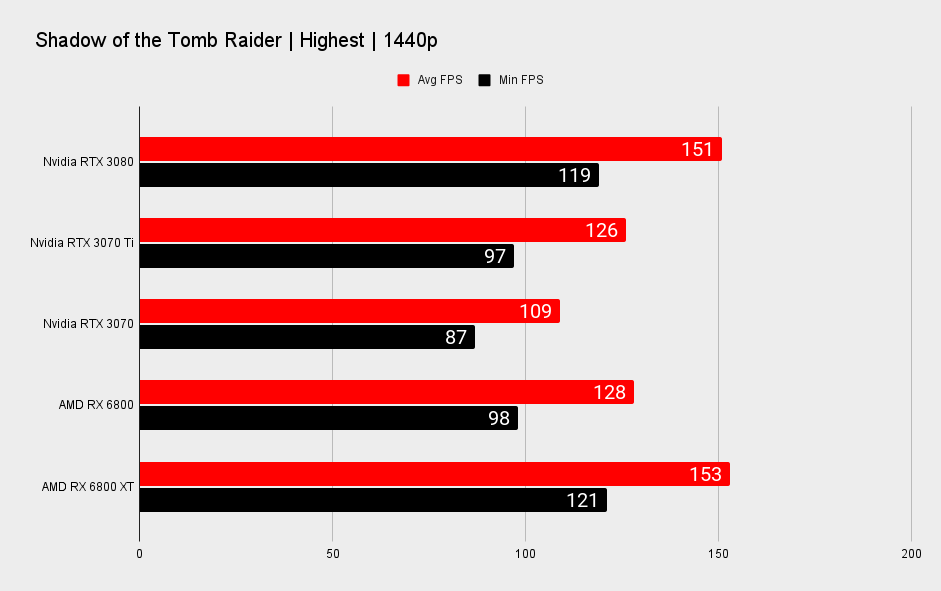
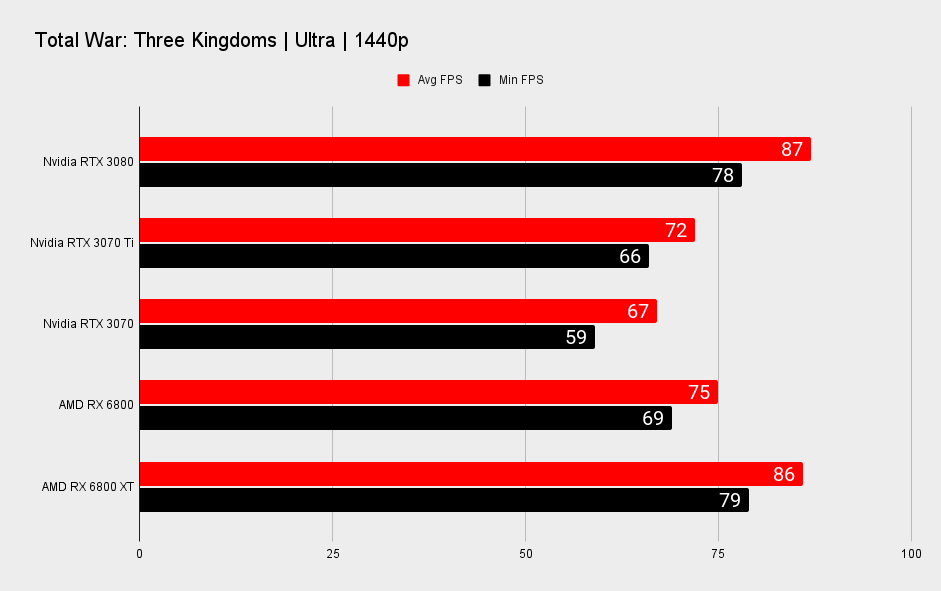
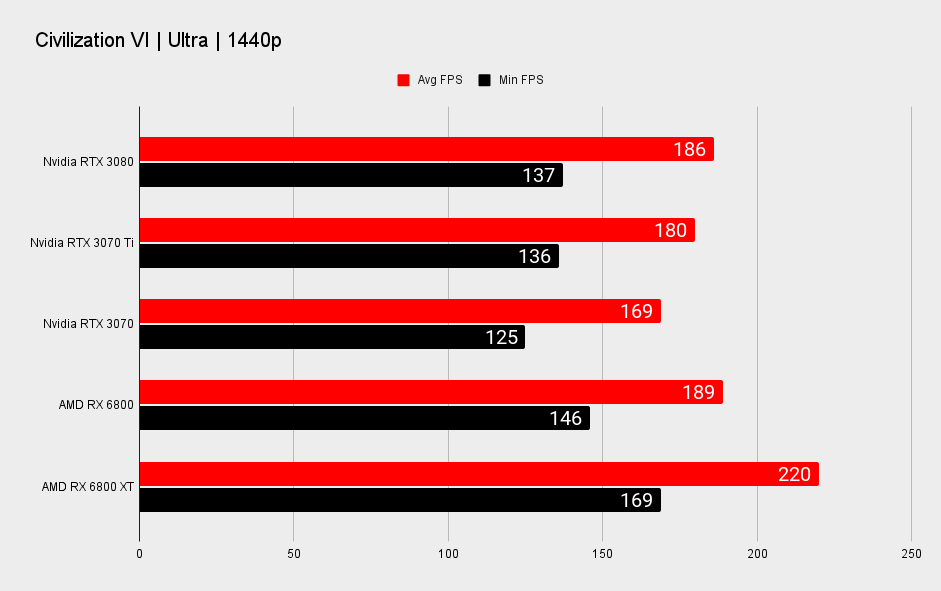
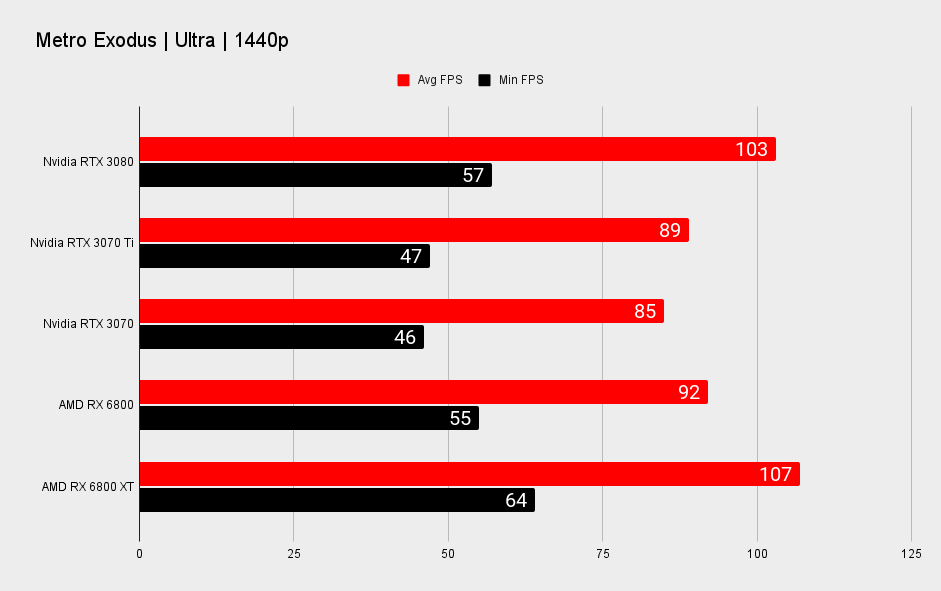
I would consider 1440p to be the RTX 3070 Ti's bread and butter. While 4K is far more attainable now than ever before, as evidenced by the performance you can see above, the mix of high fidelity and frame rates with more affordable 1440p gaming monitors is sure to tempt a good many gamers.
The RTX 3070 Ti boasts high double-digit performance in more visually-demanding games and surpasses triple digits in most everything else. Making it a decent fit for gaming at 1440p without compromising on quality or playability.
The card also tends to distance itself a little from the RTX 3070 at this resolution, although the RX 6800 largely remains out of reach. The RDNA 2 architecture is playing to its strengths at 1440p—the RX 6800, specifically, was built to conquer at this resolution, and still does.
There is one notable exception in Horizon Zero Dawn, which tends to favour Nvidia silicon through and through. You'll likely find other cases where Nvidia pulls ahead, especially as there's often only a handful of frames separating the two, but generally the RX 6800 tends to lend to faster frame rates.
1080p performance
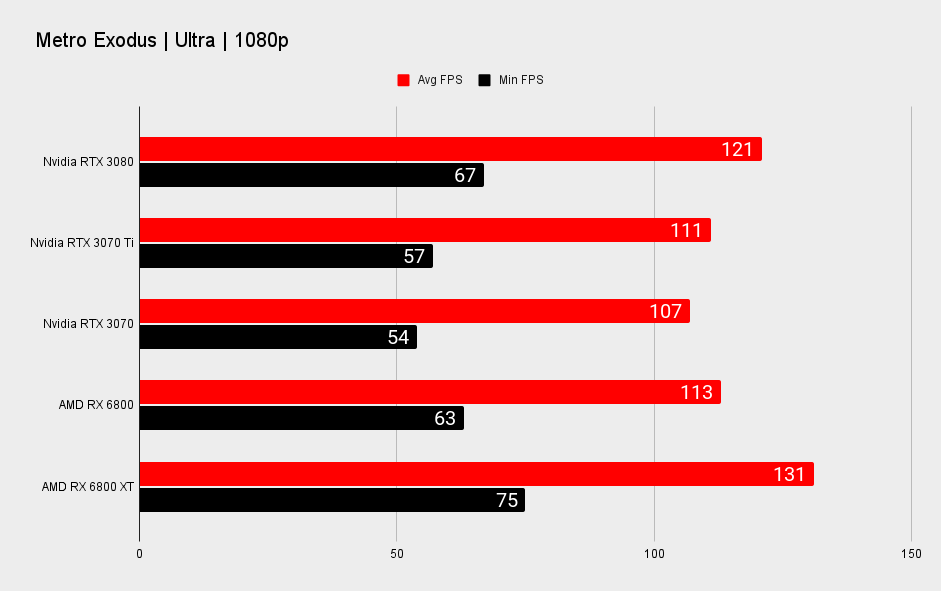

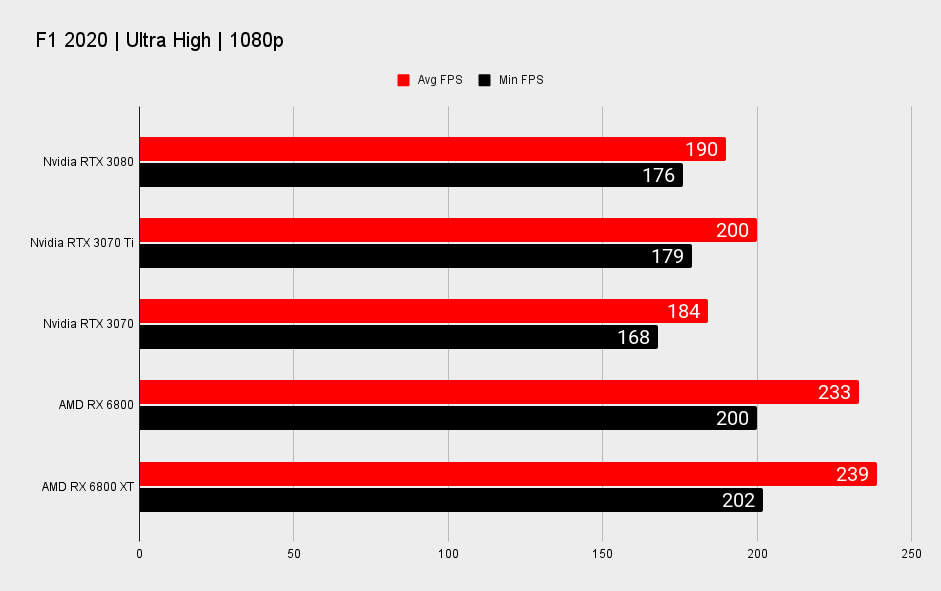
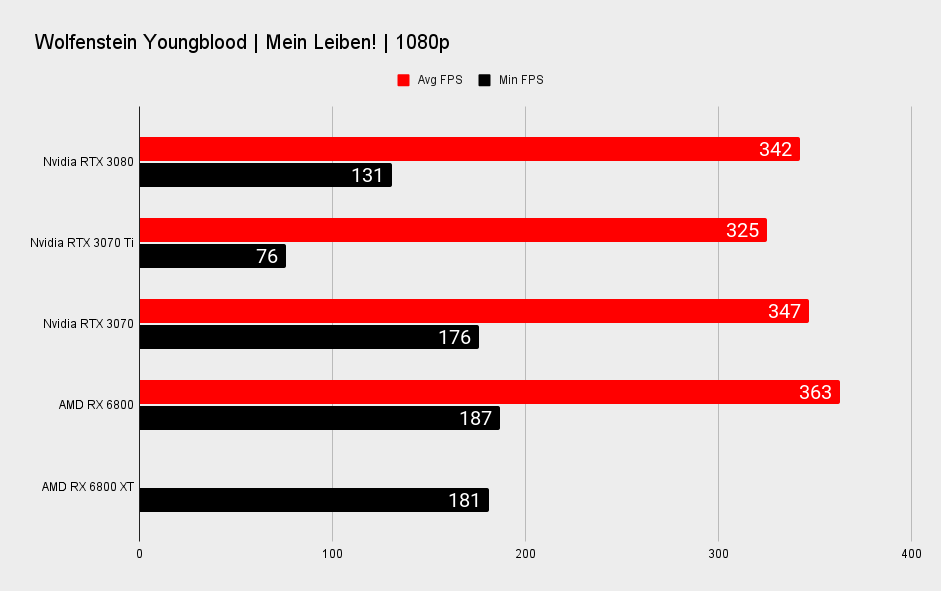
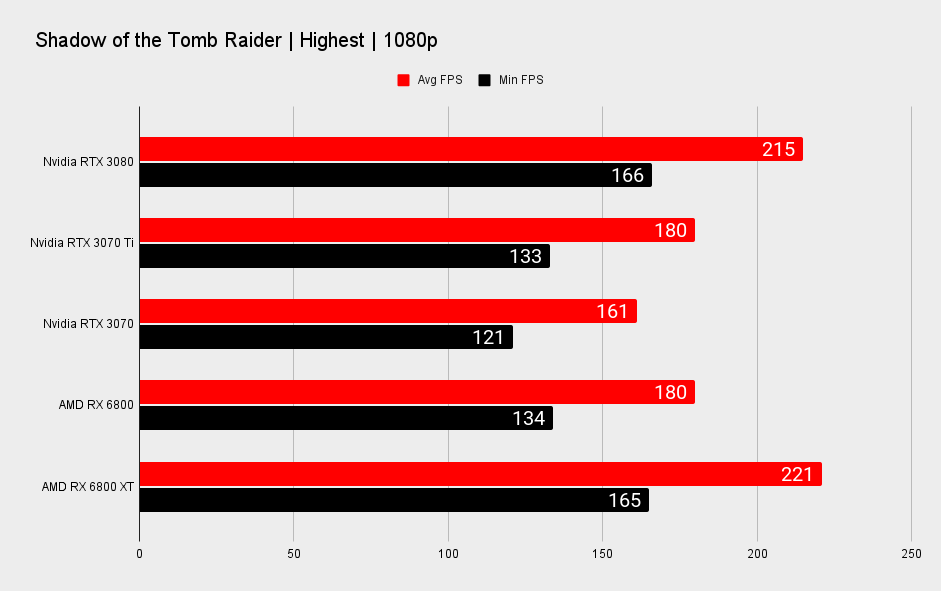
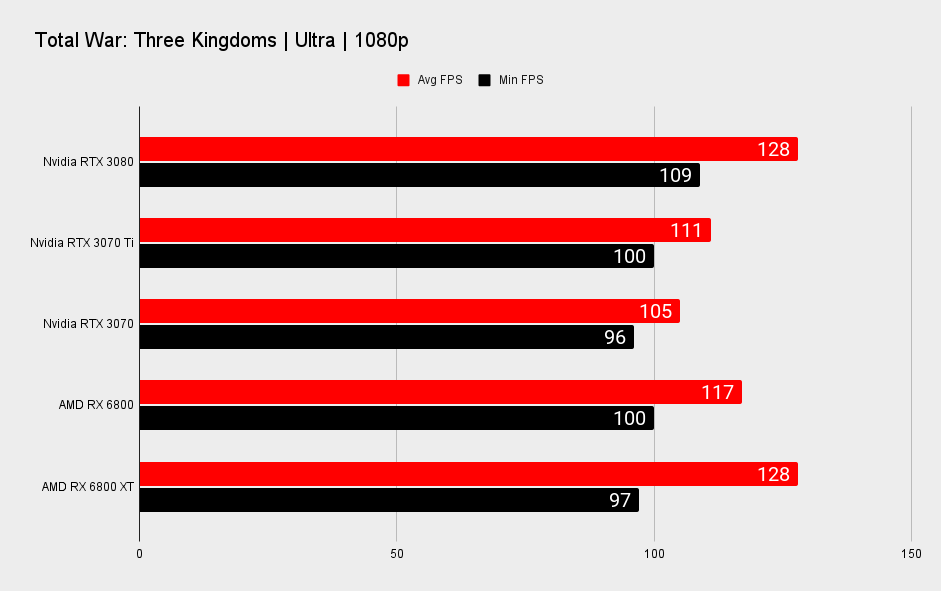
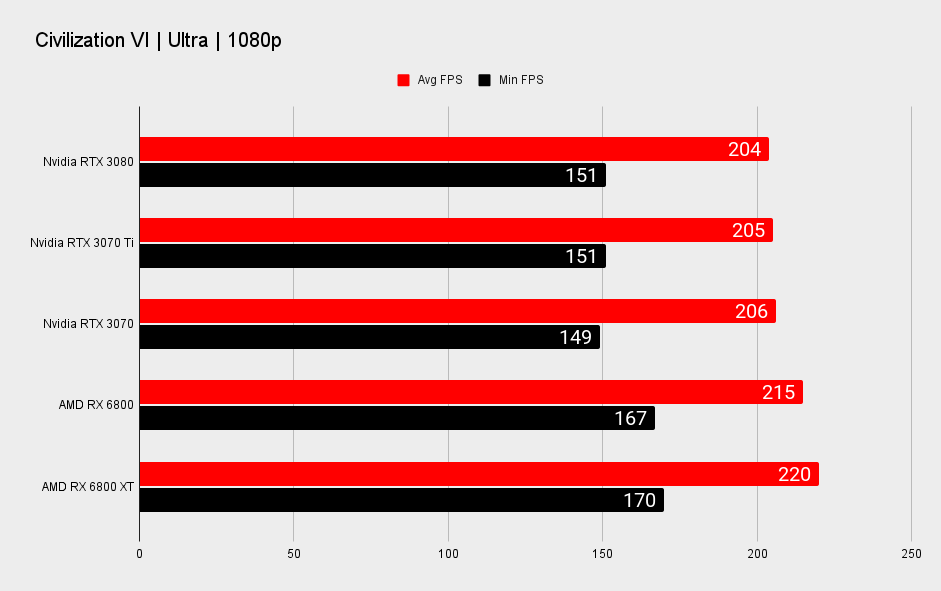
It's at 1080p where the RTX 3070 Ti most struggles to compete with AMD's RX 6800. It's here where we'd traditionally see less of a reliance on faster memory, which effectively nixes the RTX 3070 Ti's strongest feature. To make matters worse, AMD's RDNA 2 architecture tends to perform its best at 1080p.
That most often sees the RTX 3070 Ti struggle to keep apace of the cheaper RX 6800 at 1080p. It's not a tremendous lead, only single-digit percentiles separate the two in all but the games most favourable to AMD's GPUs, but it's certainly a strike against the RTX 3070 Ti when it already commands a higher price tag than the RDNA 2 chip.
The lessened impact of memory bandwidth on 1080p gaming performance also sees the RTX 3070 Ti only edge slightly ahead of the RTX 3070. At higher resolutions this performance gap tends to grow in the Ti's favour, but I wouldn't recommend opting for the more expensive card if you are only looking for 1080p performance. There's really very little in it.
If you brush aside specific GPU comparisons for a moment, however, the RTX 3070 Ti is a really solid graphics card for 1080p gaming at high frame rates. That's thankfully a bit of a given with any modern graphics card—the 1080p pixel count has become rather pedestrian for all but the slimmest iGPUs going.
Ray tracing performance




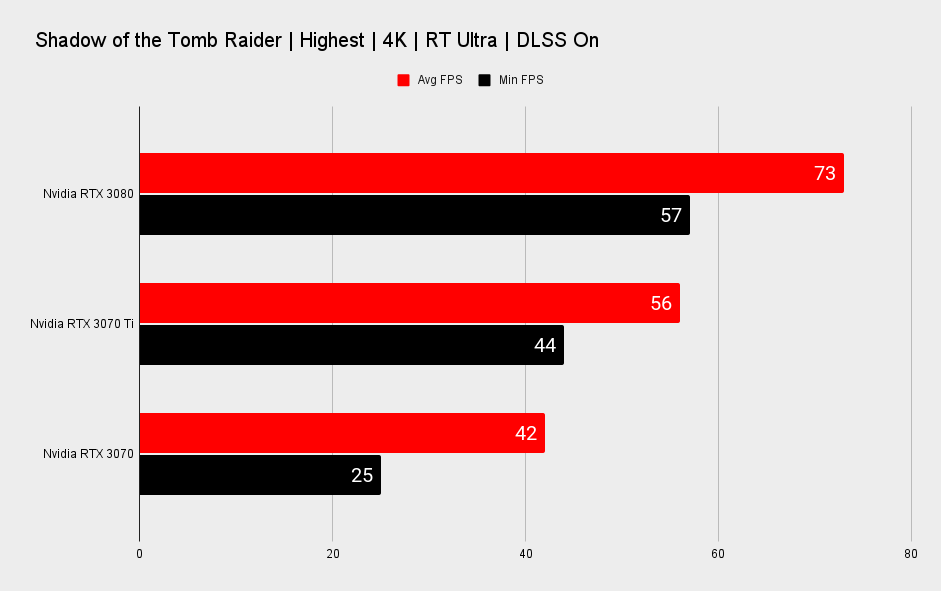
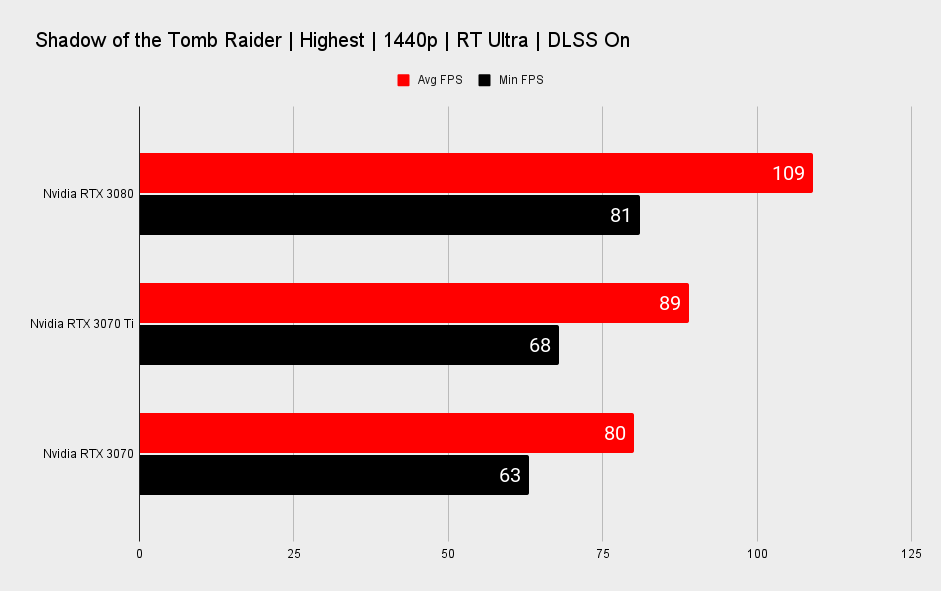
Ray tracing comes with a hefty hit to performance, but once again Nvidia's RT Cores work wonders for mitigating the impact in most games. The RTX 3070 Ti is equipped with 48 of Nvidia's second generation RT Cores, which are a notable improvement over Turing's 1st Gen lot.
That's also two more RT Cores than the RTX 3070, although those don't count for a whole lot in ray-traced performance. The two perform near-enough identically in the DXR Feature Test.
The RTX 3080 does, however, pull away from the RTX 3070 Ti in ray tracing workloads. With 68 RT Cores, that's perhaps no surprise. So if it's ray tracing performance you're after it is once again the RTX 3080 that gets our recommendation.
Importantly, though, these RT Cores are better suited for the task than AMD's equivalent Ray Accelerators, and that makes for a better ray tracing card in the RTX 3070 Ti than the Radeon RX 6800 by some margin. The RTX 3070 Ti's raw RT performance is actually superior to even the RX 6900 XT with 80 Ray Accelerators, although the rasterised performance of the RX 6900 XT will see it retain the performance lead in ray-traced games, as these blend both ray tracing and shader cores.
Saying that, it's pretty close in Metro Exodus Enhanced Edition between the RTX 3070 Ti and RX 6900 XT. The 3DMark Port Royal test, not so much. The RX 6900 XT shows a clear lead in the purpose-built benchmark.
DLSS often comes to the rescue of the RTX 3070 Ti, though. This feature is as much a boon as ever for GeForce RTX cards in supported games, although AMD will release something akin to the feature in FidelityFX Super Resolution later this month.
Thermal and power performance


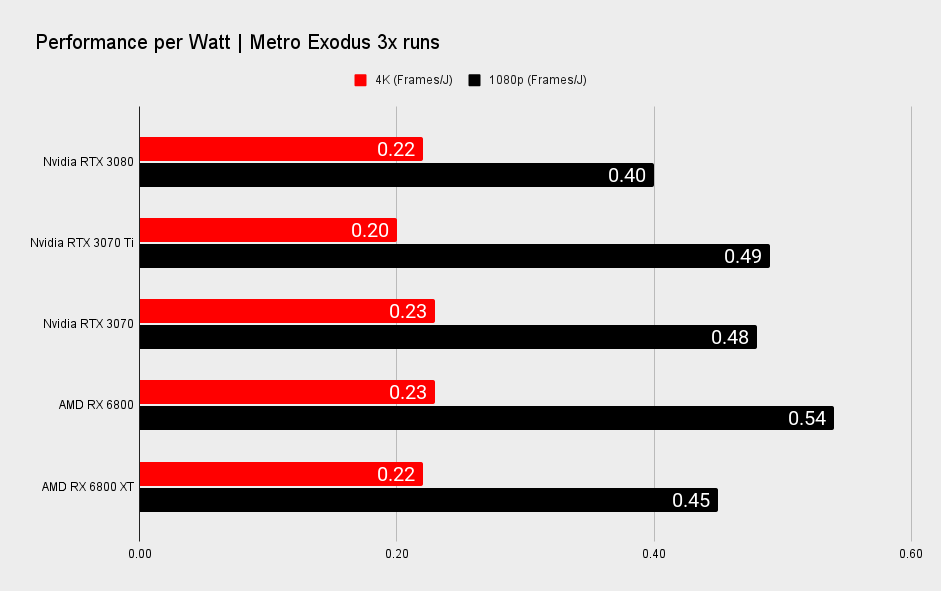
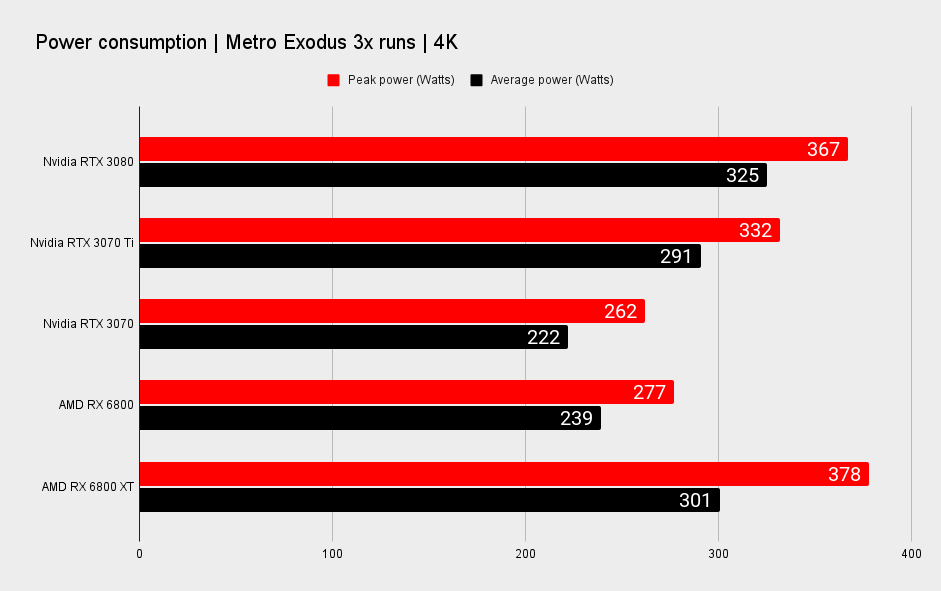
As I alluded to earlier in the specifications, the RTX 3070 Ti seems to be the result of pushing the GA104 silicon to its limit. Power demands are high, despite a not altogether massive improvement in clock speed or CUDA Core count, and therefore it demands a beefier cooler.
Yet even the slightly larger Founders Edition cooler on the RTX 3070 Ti struggles to deal with the faster, slightly chunkier spec. It reached the highest average temperature we've measured so far on any of the reference cards from Nvidia or AMD. That may go some ways to explaining the lower GPU Boost clocks in-game, as this feature uses available power and thermal headroom to boost beyond a card's original spec.
Analysis

What does the Nvidia GeForce RTX 3070 Ti mean for PC gaming?
Nvidia told me the RTX 3070 Ti had one job to do: compete with the AMD Radeon RX 6800. It does just that, but it's not a comfortable win, nor is it the RX 6800 killer I had expected at first.
AMD effectively left the door open for Nvidia to come back at it with a highly competitive card following the launch of the RX 6800. Nvidia had a card either side the RDNA 2 release at the time, the RTX 3070 at $499 and the RTX 3080 at $699, which left a sizeable window for Nvidia to exploit should it so wish. It seemed clear, then, that it would do just that with the RTX 3070 Ti, which could parachute into that gap with performance ready to make mincemeat of the RX 6800.
Fast forward to June 2021 and Nvidia is offering competition at this price bracket, but not so much a definitive answer to AMD's RX 6800. The RTX 3070 Ti stays abreast of the RDNA 2 chip at 4K but slips away from it at 1080p and, more importantly, 1440p.
In my mind this comes down to the decision to adopt only pristine GA104 GPUs for the RTX 3070 Ti. That's necessarily expensive and Nvidia nets only a small increase in CUDA Cores with the full graphics silicon; just 5%. Nvidia therefore needs to search out further performance wins elsewhere to attempt to hit its competitive goals versus AMD.
Nvidia's thrown everything at the wall to push the GA104 GPU towards RX 6800 performance.
That's where GDDR6X comes in, and the improved memory chips offer less sure-fire performance improvements across resolution than a simple CUDA core uplift. Importantly they do make those improvements stick at 4K.
Nvidia's choice of GPU comes down to many factors, and I do not care to try and speculate on all of them. What's clear here, through the performance figures to the thermal and power demands of the card, is that Nvidia's thrown everything at the wall to push the GA104 GPU towards RX 6800 performance, and its best efforts have got it something close to it, but not quite there in every regard. Certainly not without DLSS to speed its chips up, or ray tracing to slow AMD's down, anyways.
As with the RTX 3080 Ti launch, pricing has fallen on the wrong side of my own expectations.
Perhaps that's a sign of the times; graphics card demand is so immense that manufacturer set pricing doesn't mean a whole lot anymore. Yet I also feel the lack of availability of AMD's RDNA 2 chips has swayed the decision. It's all well and good us comparing the RTX 3070 Ti and RX 6800 for the purpose of this review, but out there in the wilds of retail it is hardly a comparison worth making with an obvious absence of AMD GPUs.
You take what you can get in today's GPU market and perhaps Nvidia here is playing that to its advantage. The RX 6800 would be the better choice at MSRP for rasterised gaming performance, but in lieu of that the RTX 3070 Ti is a fair alternative. With DLSS and ray tracing factored in, I dare say it's even a good one.
The RTX 3070 Ti doesn't shift much attention from the RTX 3080, however. Once again, if MSRP is anything to go on in these dire times, the RTX 3080 at $699 remains a monstrously good deal. If I were to dedicate my days to checking retailers for availability, that remains the card I'd be chasing. Similarly, if it were AMD I was after, I'd track down an RX 6800 XT as opposed to the RX 6800. There's a lot more on offer when you step into the truly high-end cards.
That will depend on your ability to allocate more of your budget to your GPU and save elsewhere, of course, which understandably isn't always a possibility.
Verdict
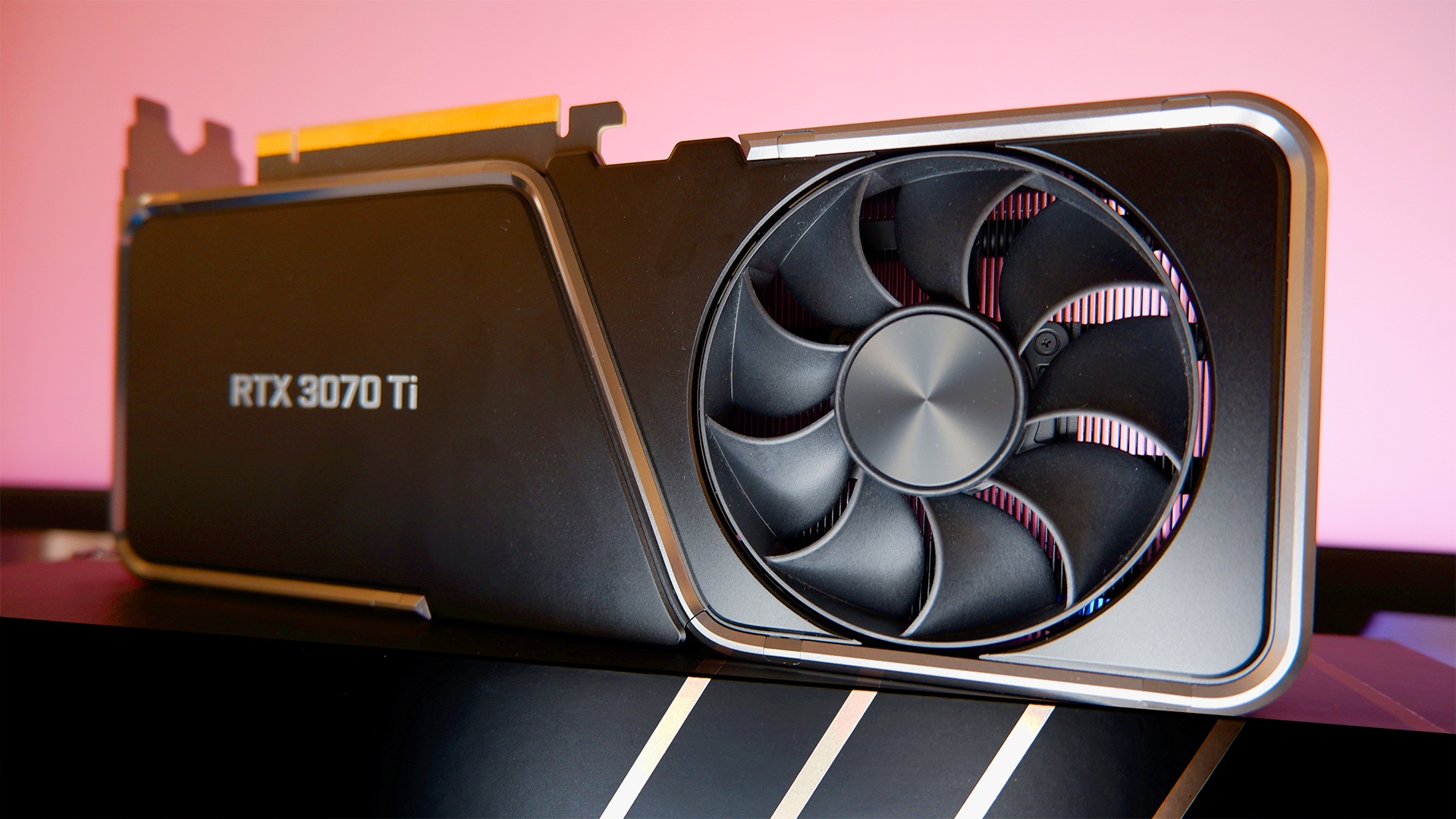
Should you buy the Nvidia GeForce RTX 3070 Ti?
Any graphics card launch is something of a blessing for anyone in the market today. It's another bite of the cherry; a chance to actually pick up a card at the price the manufacturer intended and avoid greasing the wheels of an exploitative second-hand market. That's perhaps where all of my excitement for the RTX 3070 Ti comes from, because otherwise it's a fairly utilitarian card from the green team.
The RTX 3070 Ti exists to plug a hole in the GeForce lineup where the Radeon RX 6800 currently has its elbows out. As such, the RTX 3070 Ti is nearly as much a performant 1440p graphics card, and it gets by just fine at 4K, too.
When it doesn't manage this in raw rasterised performance, it partially makes up for the deficit with Nvidia's breadth of features and a ray tracing performance lead. It could perhaps do so with a little more grace, though, as Nvidia's clearly pushing the RTX 3070 Ti to its limits in order to compete.
It's not a great deal, however—I fear the days of manufacturers throwing pricing under the bus to screw with the competition are well and truly behind us. Priced more than the RX 6800 at launch and lumped right between the RTX 3070 and RTX 3080, you pay what you might expect for the 3070 Ti's performance and possibly even a little more.
Admittedly, the small price difference between Nvidia and AMD's chips will not play a huge role in the decision to purchase for most right now—you'll be lucky to even get the chance to hit the checkout button—but it still feels like this battle may have been more fierce had we a steady supply of graphics cards on both sides.
The GeForce RTX 3070 Ti delivers frustratingly variable performance, often too close to an RTX 3070 for a price smack between it and the RTX 3080. It doesn't have quite the same impact as Ampere's best cards, but at the very least offers PC gamers another chance to pick up a graphics card at MSRP this year.

Jacob earned his first byline writing for his own tech blog. From there, he graduated to professionally breaking things as hardware writer at PCGamesN, and would go on to run the team as hardware editor. He joined PC Gamer's top staff as senior hardware editor before becoming managing editor of the hardware team, and you'll now find him reporting on the latest developments in the technology and gaming industries and testing the newest PC components.


